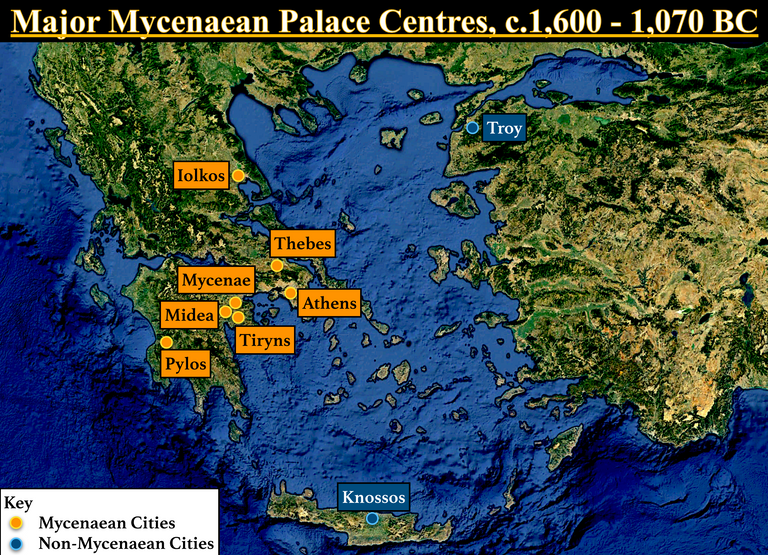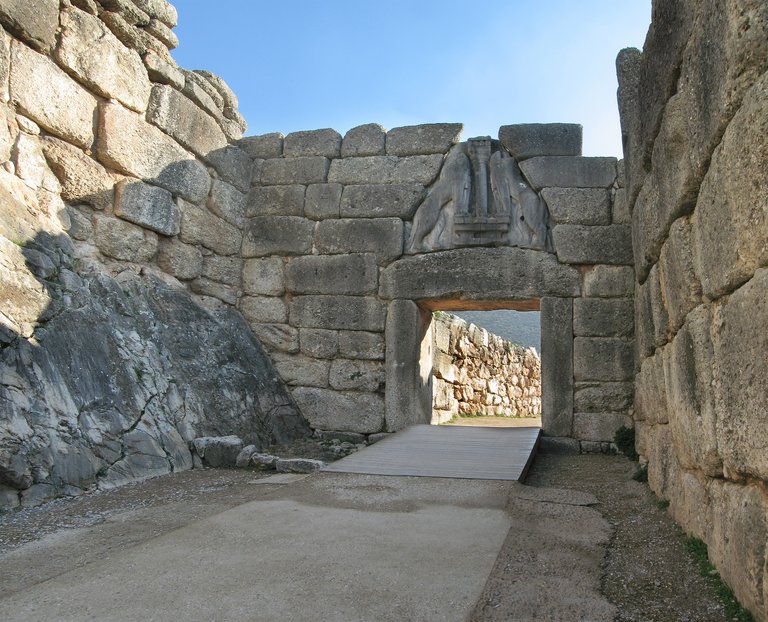The Mycenaean Era of roughly 1,600 to 1,100 BC saw the rise of important palace centres, such as Mycenae, Pylos, Tiryns, Thebes, Iolkos and Athens. For Greece, this era was the final stage of the Bronze Age, thought to have begun for the Greeks in around 3,200 BC. Some features of the Mycenaean culture include Linear B writing, palace-centred communities and tholos tombs.

EXPANSE
From around 1,600 BC, Mycenaean culture sprung from the south of Greece. Within about 150 years, their dominion expanded south to Crete, absorbing the Minoan culture already inhabiting the island, and within 200 years, their domain had stretched as far north as Thessaly. While perhaps their maritime and trading capabilities were anything to match the Minoans, they did manage to establish trading towns on Aegean islands, like Rhodes.
CITIES
Mycenaean culture was centred on walled palace sites. The more populous of these early cities were sites such as Pylos and Tiryns, and the capital (where we get the word Mycenaean) of Mycenae. These cities were constructed with large walls around the perimeter around a central square room, the palace’s focal point known as a megaron. Archives found at these palace sites, written in Linear B, have given us today a large amount of information of their economic and day-to-day lives.
MYCENAE
The Lion Gate at Mycenae, built around 1,250 BC, was the main entry point to the citadel at the Northwest side of the acropolis. It stands today as the only surviving monument of Mycenaean sculptures, and it gets is name from the two lion sculptures made in a heraldic pose above the entrance. It is the largest sculpture in the Prehistoric Aegean known to us today

(The Lion Gate at Mycenae)

(The gold death mask , believed to be King Agamemnon's, was found at Mycenae)
THOLOS TOMBS
Tholos tombs, also known as beehive tombs, (tholoi, plural) were burial sites, known for their domed shapes. The domes were made via the super positioning of successive stone or mudbrick rings, with each ring getting smaller in diameter as they neared the top. They were used mostly as burial structures throughout the Mediterranean and Asia Minor, and even as home in Cyprus, and ritual sites in Syria. In Spain and Sardinia, tholoi were used as fortresses, but though mainland Greece, they remained a Late Bronze Age development. Their exact origin is still in question, yet theories have arisen; it’s a possibility that they were inspired by the tholoi built by the Minoans in Crete, or they could have been the result of a more natural development of the tumulus mound burials which dated to the Mid-Bronze Age.

(An interior view of a Tholos tomb)
THE ROYAL TOMB OF CLYTEMNESTRA, ARGOLIS
The Royal Tomb of Clytemnestra, c.1,250 BC, Argolis, was named after the wife of King Agamemnon. The tomb is thought of by some to the the actual tomb of Agamemnon himself.
A clay tablet found at Pylos had Linear B script engraved on it. It contains information on the distribution of pig, deer and bovine hides to shoe and saddle makers. It is on display today in the National Archaeological Museum, Athens.

LINEAR B LANGUAGE
While it became known that the Minoan Cretans were definitely not Greek, the cultural status of the peoples that followed them, the Mycenaeans, was in question until 1952; Michael Ventris, a young architect from England, deciphered some clay tablets found at Pylos in mainland Greece and at Knossos. The syllabic script today known to us as Linear B was developed straight from Linear A, but the language used in recording it was shown by Michael Ventris to be a type of Greek nearest to the form of Archaic Greek known to us at the time, and so for the first time, it had been shown that the Mycenaeans were ethnically and geographically Greek.

(A Linear B tablet from Pylos)
The Mycenaean world was very separate from the Classical Greek world we’re more familiar with. The Mycenaean written records contain equipment provisions lists stored at palaces, and have information relating to the year of those pieces destruction. (These clay tablets the information survived on survived as they were baked in fires that burnt the palaces they were in.) On top of that, the limits of Linear B make any other functions for the writing seem unlikely; their culture wasn’t entirely literate, so the culture of Mycenaean Greece has to be of material remains. To reconstruct their world then is to rely on archaeology and their material culture. By definition then the Mycenaean period of Greece belongs in Pre-History instead of history, the difference being that Pre-History is any history before more complex writing seen in the later 8th century BC and onwards Greek world.
Linear B was written onto clay and stone tablets, dating back to the 15th century BC, predating the Greek alphabet by about 6 centuries. The earliest recordings of Linear B can be dated to c.1,450 BC as a descendant of Linear A, with the earliest records found mostly in palace archives at Mycenae, Knossos, Kydonia, Thebes and Pylos. Linear B was composed of about 87 syllables and around 100 ideographic signs, with ideograms representing objects and commodities of no phonetic value (that is, they didn’t relate to speech sounds like most languages do) and they were never used as word signs when writing out a sentence.
DECLINE
The hundred year timeframe from 1,250 - 1,150 BC was a destructive one; The Hittite Empire of Anatolia collapsed in c.1,200 BC, and the Sea Peoples begun their invasions across the Eastern Mediterranean, including at Egypt. The Sea Peoples were likely northern Greeks or even Mycenaeans in flight. Between 1,250 and 1,200, Troy was supposedly sacked by the Mycenaeans. In around 1,200 BC, the Mycenaean cities like Mycenae and Pylos were burnt, and their culture was again attacked in c.1,150 BC, with its palace organisations and culture being deserted. This was followed by Greeks emigrating to areas like Cyprus, and mass populations depopulating Greece-Proper. Yet some palace centres did carry on, yet they did carry on with a lower provincial level of material culture. 1,070 BC saw the last of the Mycenaean palaces abandoned, and all of this depopulating and invasions in Mainland Greece, accompanied by a possible earthquake, is what led to the period of Greek history known as the Greek Dark Ages, and the Greek world from the 8th century onwards was a result of the Dark Ages rather than the Mycenaean.
SOURCES
• World History, Eyewitness Companions, by Philip Parker, page 101
• Early Greece, Second Edition, by Oswyn Murray, pages 6-8
• Texts, Readers and Writers (CL1TR) lectures, by Professor Eleanor Dickey + Dr. Christa Gray, University of Reading
• Greek History: War, Society and Change in the Archaic Age (CL1GH) lectures, by Professor Emma Aston, University of Reading
(All images used are copyright-free.)
Epimethus on the Mycenaeans (I DO NOT own this video)
My favorite part from this post is that king's gold death mask which reminds me about how they put kings and other leaders on coins, on money. Also, those tablets are fascinating as archives of history, like an ancient screenshot or photograph in a way.
Maybe Kings had death MASKS and anyone else had only COINS on their eyes for their burials, like a symbol of more power?
Maybe.
Congratulations @oo7harv! You have completed the following achievement on the Steem blockchain and have been rewarded with new badge(s) :
You can view your badges on your Steem Board and compare to others on the Steem Ranking
If you no longer want to receive notifications, reply to this comment with the word
STOPVote for @Steemitboard as a witness to get one more award and increased upvotes!